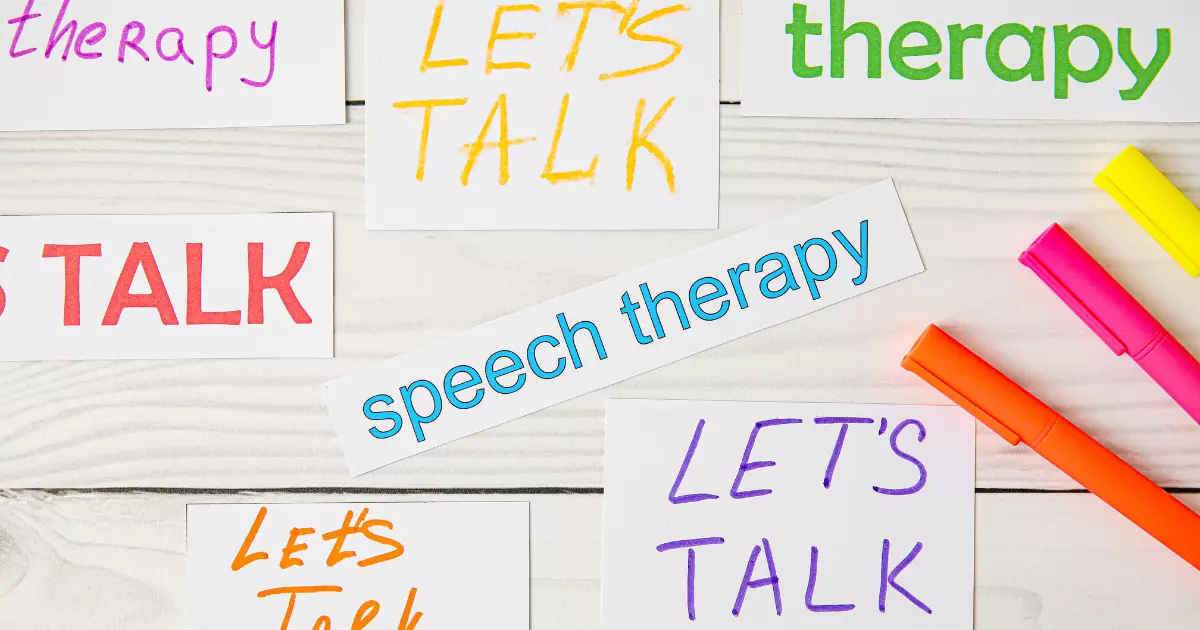Effective communication is the cornerstone of human interaction, enabling us to connect, express ourselves, and navigate the world. Speech-Language pathologists (SLPs) assist to prevent, assess, diagnose, and treat individuals with a variety of speech, language, and social communication delays and disorders to enhance their development. There are a variety of evidence-based practices that a speech-language pathologist may use for intervention. One of which is the Early Start Denver Model (ESDM), which has gained recognition for its comprehensive approach to early intervention in children with autism spectrum disorders.
In this blog, we will delve into the world of Speech-Language Pathology and explore how ESDM treatment can unlock the potential of children, fostering their communication abilities and enhancing their overall development.
Understanding Speech and Language Development in Children
Developing speech and language skills is a remarkable milestone in a child’s early years. From non-verbal language (e.g., gestures), their first babble, to full sentences, children embark on a transformative communication journey.
Understanding the intricacies of speech and language development is crucial for parents, caregivers, and educators to support and nurture these skills effectively.
By gaining insights into the typical progression and potential red flags, we can better equip ourselves to promote healthy communication habits and help children unleash the power of practical expression.
Milestones for Speech and Language Development in Children

A speech and language therapist can help children’s development, which is a captivating journey marked by crucial milestones. From their earliest vocalizations to their ability to engage in meaningful conversations, these milestones provide insights into a child’s communication skills and progress.
Key milestones include non-verbal gestures, babbling, first words, combining words, and developing a diverse vocabulary. Additionally, important markers encompass receptive language (understanding spoken language) and expressive language (using words and sentences).
As children reach these milestones, their ability to engage in social communication also expands. By recognizing and supporting these milestones, we can help children reach their full speech and language development potential, fostering effective communication skills for a lifetime.
Common Speech and Language Disorders in Children
Speech and language disorders can pose significant challenges for children, impacting their ability to communicate and connect with others effectively. Some prevalent speech disorders include articulation disorders (difficulties producing certain sounds /s/), phonological disorders (errors in sound patterns), and fluency disorders (such as stuttering).
Language disorders encompass expressive language disorders (trouble forming sentences), receptive language disorders (difficulty understanding spoken language), and pragmatic language disorders (struggles with social communication).
Understanding these common disorders is crucial for early identification and intervention. By recognizing the signs and seeking appropriate support, parents, caregivers, and professionals can play a vital role in helping children overcome these disorders and improve their communication abilities.
The Impact of Speech and Language Disorders on Children’s Development and Well-Being
Speech and language disorders can significantly impact a child’s development and well-being. These disorders can create barriers to effective communication, leading to difficulties in academic performance, social interactions, and emotional well-being.
Language delays or disorders may hinder a child’s ability to express thoughts and feelings, causing frustration and affecting self-esteem.
Moreover, untreated speech sounds disorders may lead to social isolation, as children may face difficulties being understood by family and peers. Recognizing the impact of speech and language disorders is crucial for early intervention and providing appropriate support, enabling children to reach their full potential and thrive in all aspects of life.
Speech & Language Services for Children
Speech and language services offer invaluable support to children with communication disorders, enabling them to overcome challenges and unlock their potential.
SLPs, also known as speech therapists, specialize in diagnosing and treating various speech, language, and social communication disorders.
Through individualized therapy sessions, they address articulation difficulties, language delays, stuttering, voice disorders, and more. SLP services encompass comprehensive assessments, personalized treatment plans, and evidence-based interventions tailored to each child’s needs.
By fostering improved speech clarity, language comprehension, and expressive abilities, speech and language services enhance a child’s communication skills, boosting self-confidence, academic success, social interactions, and overall well-being.
What Is a Speech-Language Pathologist (SLP)?
A Speech-Language Pathologist (SLP) is a highly trained professional dedicated to diagnosing and treating communication disorders in individuals of all ages. These skilled practitioners possess expertise in speech, language, social communication, fluency, and more.
SLPs play a pivotal role in assessing and providing interventions for various conditions such as articulation disorders, language delays, fluency disorders, social communication disorders, and more depending on the setting.
Through their specialized knowledge and therapeutic techniques, SLPs work closely with individuals to improve speech clarity, enhance language skills, and promote effective social communication skills.
Their compassionate approach and commitment to helping individuals achieve optimal communication make them invaluable champions in speech-language pathology.
Types of Speech & Language Services for Children
Speech-Language Pathology (SLP) services for children encompass a range of specialized interventions tailored to address diverse communication challenges. These services are designed to support children in overcoming speech, language, and social communication disorders, enhancing their communication skills and overall development.
Let’s explore some of the key types of SLP services available for children:
- Assessment and Diagnosis: SLP professionals conduct comprehensive assessments to evaluate a child’s speech, language, and social communication abilities. Through standardized tests, observations, and interviews, they gather information to determine the nature of the communication disorder.
- Articulation Therapy: Articulation therapy focuses on improving the clarity of speech sounds. SLPs work with children to correct pronunciation errors and develop proper speech production techniques.
- Language Therapy: Language therapy enhances a child’s receptive and expressive language skills. SLPs employ strategies to improve vocabulary, sentence formation, grammar, and comprehension.
- Fluency Therapy: SLPs provide fluency therapy to children experiencing stuttering or other fluency disorders. Techniques such as breathing exercises, relaxation strategies, and speech pacing promote fluent speech.
- Social Communication Skills Training: SLPs assist children in developing social communication skills, including nonverbal cues, turn-taking, initiating and maintaining conversations, and understanding social contexts.
The Benefits of Early Intervention for Speech and Language Disorders in Children

Early intervention is crucial when addressing speech and language disorders in children. Prompt identification and treatment of communication challenges can profoundly impact a child’s development and future success.
Let’s explore the key benefits of early intervention for speech and language disorders:
- Enhanced Communication Skills: Early intervention allows for timely and targeted support, helping children improve their speech clarity, language comprehension, and expressive abilities. This enables them to effectively communicate their needs, thoughts, and emotions, fostering stronger connections with others.
- Social and Emotional Development: Communication is vital in social interactions and emotional well-being. Early intervention helps children develop crucial social communication skills, such as turn-taking, listening, and expressing themselves appropriately. This can enhance their confidence, self-esteem, and overall social competence.
- Improved Cognitive Skills: Language development is closely tied to cognitive development. Early intervention targets language delays or impairments, supporting cognitive processes like problem-solving, critical thinking, and memory.
- Prevention of Secondary Challenges: Untreated speech and language disorders can lead to secondary challenges, including academic struggles, social isolation, and emotional difficulties. Early intervention helps mitigate these potential long-term consequences, providing children with the tools they need to thrive.
- Family Involvement and Support: Early intervention programs often involve families and caregivers, equipping them with strategies and resources to support their child’s communication development at home. This collaborative approach strengthens the child’s support system and promotes consistency in communication strategies.
Early Start Denver Model (ESDM) Treatment for Children with Autism Spectrum Disorder (ASD)
The Early Start Denver Model (ESDM) is an evidence-based, early intervention program designed specifically for children diagnosed with Autism Spectrum Disorder (ASD). This comprehensive treatment approach promotes social communication skills, cognitive development, and adaptive behaviors in young children.
ESDM combines developmental and behavioral strategies in a play-based, naturalistic setting. The program emphasizes creating a positive and engaging learning environment that maximizes the child’s motivation and promotes skill acquisition.
Through structured activities, joint attention, imitation, and naturalistic teaching methods, ESDM aims to enhance social interactions, language and communication abilities, and overall developmental outcomes for children with ASD, paving the way for improved lifelong outcomes.
What is the Early Start Denver Model (ESDM)?
The Early Start Denver Model (ESDM) is a comprehensive, evidence-based early intervention approach for children diagnosed with or at risk of Autism Spectrum Disorder (ASD). It combines principles of developmental psychology with applied behavioral analysis techniques.
ESDM focuses on enhancing young children’s social communication skills, language development, cognitive abilities, fine motor skills, and adaptive behaviors.
The program utilizes play-based and naturalistic settings that incorporate everyday activities to promote natural and engaging learning. ESDM emphasizes building positive relationships, encouraging joint attention, and utilizing behavioral techniques to support skill acquisition.
The Research Behind ESDM for Children With ASD
The Early Start Denver Model (ESDM) for children with Autism Spectrum Disorder (ASD) is backed by extensive research and empirical evidence.
Studies have demonstrated the effectiveness of ESDM in improving social communication skills, language development, and overall developmental outcomes in young children with ASD.
Research has shown that children who received ESDM intervention exhibited significant improvements in cognitive abilities, social engagement, adaptive behaviors, and reduced symptoms of ASD.
Long-term follow-up studies have also revealed sustained positive effects of ESDM intervention. The research behind ESDM underscores its evidence-based approach, highlighting the importance of early intervention and the potential for transformative outcomes in children with ASD.
The Components of ESDM Treatment for Children With ASD
ESDM treatment for children with ASD consists of several vital components. First, it emphasizes building positive relationships between the child and therapist, creating a nurturing and engaging environment.
Second, ESDM utilizes play-based activities to facilitate learning and skill acquisition. It targets social communication skills, language development, cognitive abilities, and adaptive behaviors.
ESDM incorporates naturalistic teaching methods, such as joint attention and imitation, to promote learning in everyday situations. It also involves parental involvement, providing training and support to extend intervention strategies into the home environment.
The Benefits of ESDM Treatment for Children With ASD
ESDM treatment for children with ASD offers numerous benefits that can significantly impact their development and quality of life.
Here are some key advantages of ESDM:
- Enhancing Social Communication: ESDM focuses on improving social communication skills, such as joint attention, social interaction, and nonverbal communication. By targeting these areas, children with ASD can better engage with others, develop friendships, and navigate social situations more effectively.
- Language Development: ESDM strongly emphasizes language acquisition, helping children with ASD improve their expressive and receptive language skills. By targeting vocabulary, grammar, and pragmatic language abilities, ESDM facilitates better communication and the expression of thoughts and emotions.
- Cognitive Development: ESDM interventions support cognitive development by fostering skills like problem-solving, memory, and attention. Children are encouraged to think critically, make connections, and develop cognitive flexibility through play-based activities.
- Adaptive Behaviors: ESDM aims to improve adaptive behaviors, including daily living skills, self-help skills, and independence. By focusing on these essential areas, children with ASD can gain greater autonomy and become more self-sufficient in their daily lives.
- Parental Involvement and Empowerment: ESDM actively involves parents in the treatment process. Parents receive training and guidance, enabling them to reinforce intervention strategies at home and in everyday routines. This involvement empowers parents to actively support their child’s progress and generalize skills beyond therapy sessions.
How to Find an ESDM Provider for Your Child With ASD
Finding an Early Start Denver Model (ESDM) provider for your child with Autism Spectrum Disorder (ASD) involves several steps. Start by researching local providers who specialize in early intervention and ASD. You can find certified ESDM providers using the following link: https://www.esdm.co/esdm-therapists or you can contact the team at BV Psychological Solutions.
Consult with your child’s pediatrician or seek recommendations from local autism organizations or support groups. Look for professionals who have received specific training in ESDM and have experience working with children with ASD. Consider location, availability, and compatibility with your child’s needs and preferences.
It’s also important to verify insurance coverage and discuss financial considerations. Ultimately, selecting an ESDM provider involves finding a trusted professional who aligns with your child’s unique needs and can support their development and well-being.
ESDM Treatment for Children with Developmental Delays or Disabilities
ESDM (Early Start Denver Model) is a comprehensive, evidence-based treatment approach designed for children with developmental delays or disabilities. This therapeutic intervention focuses on improving young children’s social communication, language, and cognitive skills.
ESDM combines applied behavior analysis (ABA) principles with developmental and relationship-based techniques. ESDM aims to enhance a child’s social engagement, imitation abilities, and adaptive behaviors through play-based activities and naturalistic teaching strategies.
It promotes positive parent-child interactions and generalizes learned skills in various settings. ESDM has shown promising results in improving outcomes for children with developmental delays, fostering their overall development and increasing their chances for a brighter future.
How ESDM Can Be Adapted for Children With Other Developmental Delays or Disabilities
ESDM is a versatile treatment approach that can be adapted to meet the specific needs of children with various developmental delays or disabilities. Its core principles of play-based learning, naturalistic teaching, and positive relationships can be applied across different conditions.
For children with autism spectrum disorder (ASD), ESDM can address their social communication challenges and support their cognitive and language development.
When working with children with Down syndrome, ESDM can focus on enhancing their communication skills, motor development, and adaptive behaviors. Similarly, for children with intellectual disabilities or speech delays, ESDM can provide tailored interventions to promote their overall growth and functional abilities.
The Benefits of ESDM for Children With Developmental Delays or Disabilities
ESDM (Early Start Denver Model) provides numerous benefits for children with developmental delays or disabilities.
Here are some key advantages:
- Early Intervention: ESDM starts as early as 12 months, taking advantage of the brain’s high plasticity during this critical period, maximizing the potential for positive outcomes.
- Comprehensive Approach: ESDM addresses various aspects of development, including social communication, language, cognitive skills, and adaptive behaviors, promoting well-rounded and holistic development.
- Play-Based Learning: ESDM utilizes play as the primary mode of teaching, making therapy enjoyable, engaging, and natural for children. This approach enhances their motivation, participation, and overall progress.
- Parent Involvement: ESDM actively involves parents as essential treatment partners. They receive training to implement ESDM techniques at home, promoting consistency and generalization of skills in everyday life.
- Individualized Interventions: ESDM recognizes the unique strengths, challenges, and interests of each child, tailoring interventions to their specific needs. This personalized approach optimizes outcomes and addresses individual differences.
ESDM Treatment for Children of Different Age Groups
Early Start Denver Model (ESDM ) treatment can be adapted to accommodate children of different ages, tailoring interventions to their specific developmental needs.
Early Start Denver Model focuses on early intervention for infants and toddlers, targeting social communication, joint attention, and basic cognitive skills through play-based activities.
ESDM expands to include language development, pre-academic skills, and peer interactions in preschool-aged children. ESDM incorporates more structured teaching methods for older children to address complex language, academic, and adaptive skills.
Regardless of age, ESDM maintains its core principles of relationship-based therapy, parent involvement, and individualized interventions, promoting optimal growth and development at every stage.
ESDM Treatment for Infants and Toddlers (0-3 Years Old)
ESDM treatment for infants and toddlers aged 0-3 years focuses on early intervention to promote social communication, joint attention, and basic cognitive skills. Through play-based activities, a speech therapist for toddlers creates a nurturing environment that encourages exploration, interaction, and development in the crucial early years of a child’s life.
ESDM Treatment for Preschool-Aged Children (3-5 Years Old)
ESDM treatment for preschool-aged children, typically between 3-5 years old, expands to include language development, pre-academic skills, and peer interactions. Through structured play activities, ESDM and the children’s speech therapist foster social engagement, language acquisition, and cognitive growth, preparing children for the transition to school and further learning opportunities.
The Unique Challenges and Opportunities of ESDM Treatment for Children of Different Age Groups

ESDM treatment for children of different age groups presents unique challenges and opportunities. For infants and toddlers, the focus is on early intervention, capitalizing on their rapid brain development.
Preschool-aged children benefit from language and pre-academic skill development, while school-aged children require more structured interventions to address complex skills.
The challenges lie in adapting the treatment approach to meet the specific developmental needs of each age group. However, the opportunities lie in utilizing age-appropriate strategies, promoting optimal growth, and maximizing the potential for positive outcomes at each stage of development.
Working with Parents and Caregivers in Speech Therapy and ESDM Treatment
Working with parents and caregivers is crucial in speech therapy and ESDM treatment. Collaboration and active involvement of parents/caregivers are essential for successful outcomes.
Speech-language pathologists and ESDM therapists provide guidance, education, and support to help parents understand their child’s needs and implement strategies at home. This partnership promotes consistency and generalization of skills and creates a supportive environment for the child’s development.
Therapy extends beyond sessions by empowering and equipping parents/caregivers with knowledge and skills, leading to more significant progress and enhancing the child’s overall communication and developmental growth.
Strategies for Involving Parents and Caregivers in Speech Therapy and ESDM Treatment
Involving parents and caregivers in speech therapy and ESDM treatment can be achieved through various strategies.
These include regular communication to provide updates and guidance. Conducting parent training sessions to teach techniques and strategies, involving parents in therapy sessions to observe and participate, providing resources and materials for home practice, and encouraging open dialogue and feedback.
By actively engaging parents and caregivers, they become valuable partners in the treatment process, promoting consistency and generalization of skills and empowering them to support their child’s communication and developmental progress at home.
The Benefits of Family-Centered Care for Children With Speech and Language Disorders
Family-centered care is vital in supporting children with speech and language disorders.
Here are several benefits of this approach:
- Individualized Intervention: Involving families allows tailored interventions that align with the child’s needs and goals. SLPs can work closely with parents to develop practical, meaningful, and effective strategies within the family’s context.
- Increased Engagement and Progress: Family involvement enhances the child’s engagement in therapy. When parents are actively engaged and supportive, the child feels encouraged and motivated to participate and progress.
- Continuity of Support: Family-centered care extends support beyond the therapy session. Parents become equipped with knowledge, resources, and strategies to support their child’s communication development continuously, fostering continuous progress and improvement.
- Emotional Support: Speech and language disorders can be challenging for families. Family-centered care provides emotional support and empowers parents by offering a platform for sharing concerns, discussing progress, and accessing resources and guidance.
- Consistency and Generalization: When parents actively participate in therapy and implement strategies at home, it promotes consistency. This consistency aids in the generalization of skills, ensuring that the child can use their communication abilities in various environments and with different communication partners.
Find Speech Language Pathologist
Finding a skilled and experienced speech-language pathologist (SLP) is crucial for children with speech and language disorders. BVPS team can provide the necessary assessment, intervention, and support tailored to the child’s needs, facilitating their communication development and improving their overall quality of life. Contact us today to learn more!









